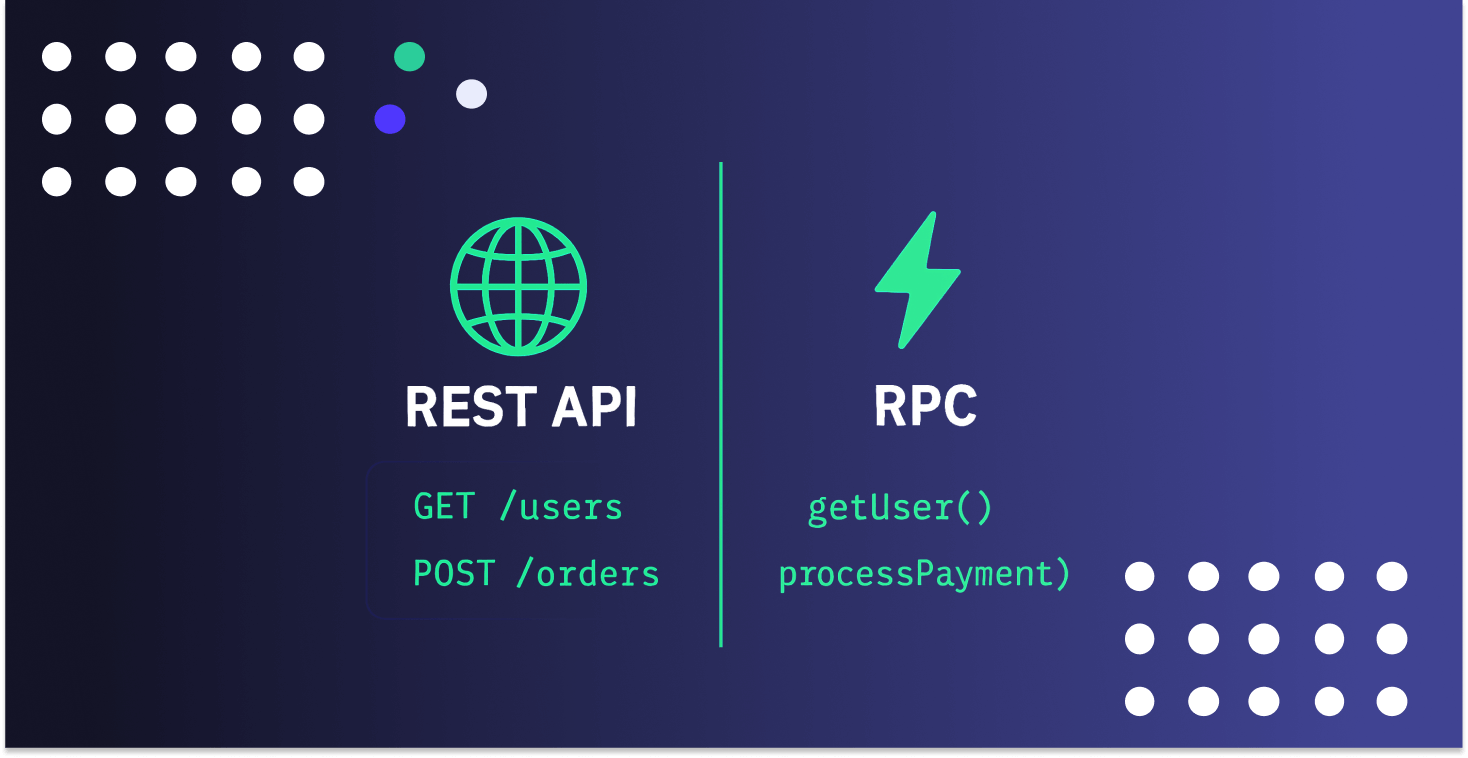RPC vs. API: Key Differences Explained



When building web services or distributed systems, understanding the differences between RPC (Remote Procedure Call) and APIs (Application Programming Interfaces) is essential. While both serve the purpose of communication between software components, they differ in design, data handling, protocols, and use cases.
In this guide, we’ll break down RPC vs API, explore key comparisons like REST API vs RPC, and provide real-world examples to help you decide which approach suits your architecture.
An API (Application Programming Interface) defines a set of rules and protocols for how different software components communicate. APIs expose endpoints and enable developers to access or manipulate data and services.
Common Types of APIs
APIs are resource-oriented, meaning they expose endpoints like /data or /nfts.
Remote Procedure Call (RPC) is a protocol that allows a program to call a function on a remote server as if it were a local function. Instead of interacting with resources, RPC focuses on actions and procedures.
Types of RPC
RPC is action-oriented, meaning it focuses on executing specific functions (e.g., getUserById(123)).
| Feature | REST API | RPC (JSON-RPC, XML-RPC, gRPC) |
|---|---|---|
| Design | Resource-based (nouns like /users) | Action-based (verbs like getUser) |
| Protocol | HTTP (stateless) | Can use HTTP, WebSockets, or custom protocols |
| Data Format | JSON, XML, others | JSON (JSON-RPC), XML (XML-RPC) |
| Flexibility | Standardized, cache-friendly | More flexible in function calls |
| Performance | Slightly slower due to HTTP overhead | Faster (especially gRPC) |
| Use Cases | Web services, public APIs | Microservices, internal APIs |
GET /users/123
Response: { "id": 123, "name": "Alice" } POST /rpc {
"jsonrpc": "2.0",
"method": "getUser",
"params": { "id": 123 },
"id": 1
}
Response: { "jsonrpc": "2.0", "result": { "id": 123, "name": "Alice" }, "id": 1 } Use REST API When:
You need a standardized, cache-friendly interface.
REST APIs are designed around the principles of HTTP and use predictable, resource-based URLs. This makes them an excellent choice for public-facing APIs where consistency and discoverability matter. Built-in HTTP features like caching, content negotiation, and status codes make REST particularly well-suited to serving data to clients efficiently and reliably across distributed systems.
Your operations are CRUD-based (Create, Read, Update, Delete).
If your application primarily manages resources—such as retrieving records, creating new entries, updating existing data, or deleting items—a REST API provides a natural, well-understood structure. The mapping of HTTP verbs (GET, POST, PUT, DELETE) to CRUD actions helps keep your API intuitive, making it easier for other developers to adopt and integrate with.
You want better scalability and statelessness.
REST’s stateless nature means that each request from a client must contain all the information necessary for the server to fulfill it. This simplifies horizontal scaling and load balancing because any server can handle any request without needing to maintain session state. If you expect high volumes of traffic or need to serve clients across the globe, REST can help your system remain robust and scalable.
Use RPC When:
You need high-performance communication.
Remote Procedure Call (RPC) frameworks—especially modern options like gRPC—are optimized for speed and low latency. In environments where services must communicate frequently and efficiently, such as within microservice architectures or between backend systems, RPC protocols can drastically reduce overhead compared to REST. They often use binary formats (like Protocol Buffers) that are faster to serialize and transmit.
Your operations are function-driven.
RPC excels when your system is oriented around discrete operations rather than resources. For example, if your API exposes procedures such as calculateTax, processPayment, or generateReport, RPC allows you to call these functions directly as if they were local methods. This makes it easier to model complex workflows that don’t neatly fit the CRUD paradigm.
You prefer minimal overhead.
Unlike REST, which must encode metadata in HTTP and text-based formats like JSON, RPC frameworks are designed to minimize protocol overhead. gRPC, in particular, uses HTTP/2 multiplexing and compact binary serialization, which reduces network usage and improves performance in low-latency scenarios. If every millisecond counts, RPC is often the better choice.
| FAQs: API vs RPC | |
|---|---|
| What is the difference between an RPC call and an API call? | An API call (especially in REST) targets a resource via a URL, while an RPC call invokes a specific function or method directly on a remote server. |
| Is the REST API the same as RPC? | No. REST APIs are resource-oriented and use standard HTTP verbs, while RPC APIs are action-oriented and can work over multiple transport protocols. |
| What is the difference between RESTful API vs RPC? | RESTful APIs expose resources (like /products or /orders), whereas RPC is used to perform actions (such as getOrderDetails or processPayment). REST is more standardized, while RPC is often faster and more flexible. |
| Which is better: REST API or RPC? | It depends on the use case. Use REST for public web APIs where standardization and discoverability are important, and RPC for internal or microservice-to-microservice communication where performance is critical. |
| JSON-RPC vs REST API – Which is faster? | JSON-RPC tends to be faster due to less protocol overhead, especially in high-frequency internal systems. REST is preferable when API discoverability, caching, and broad compatibility are priorities. |
Choosing between REST and RPC ultimately depends on your system’s goals and the nature of the interactions you need to support. REST APIs excel in scenarios where you need a standardized, resource-based approach that leverages HTTP semantics, making them ideal for public-facing web services and APIs that benefit from caching, discoverability, and broad client compatibility.
On the other hand, RPC frameworks—especially modern options like JSON-RPC and gRPC—are designed for high-performance, function-driven workflows. They shine when you require low-latency communication between internal services, complex business operations modeled as procedures rather than resources, or efficient binary serialization to reduce network overhead.
For many modern applications, especially those built on microservices architectures, gRPC is emerging as a preferred choice thanks to its strong typing, streaming capabilities, and excellent performance over HTTP/2.
In short, if you’re building a public API for developers or third-party integrations, REST is often the best fit. If you’re designing internal services that need fast, reliable communication at scale, consider adopting RPC. Carefully weigh your project’s needs for performance, flexibility, and interoperability before making your decision.
Build blockchain apps faster with a unified framework for 60+ blockchain protocols.